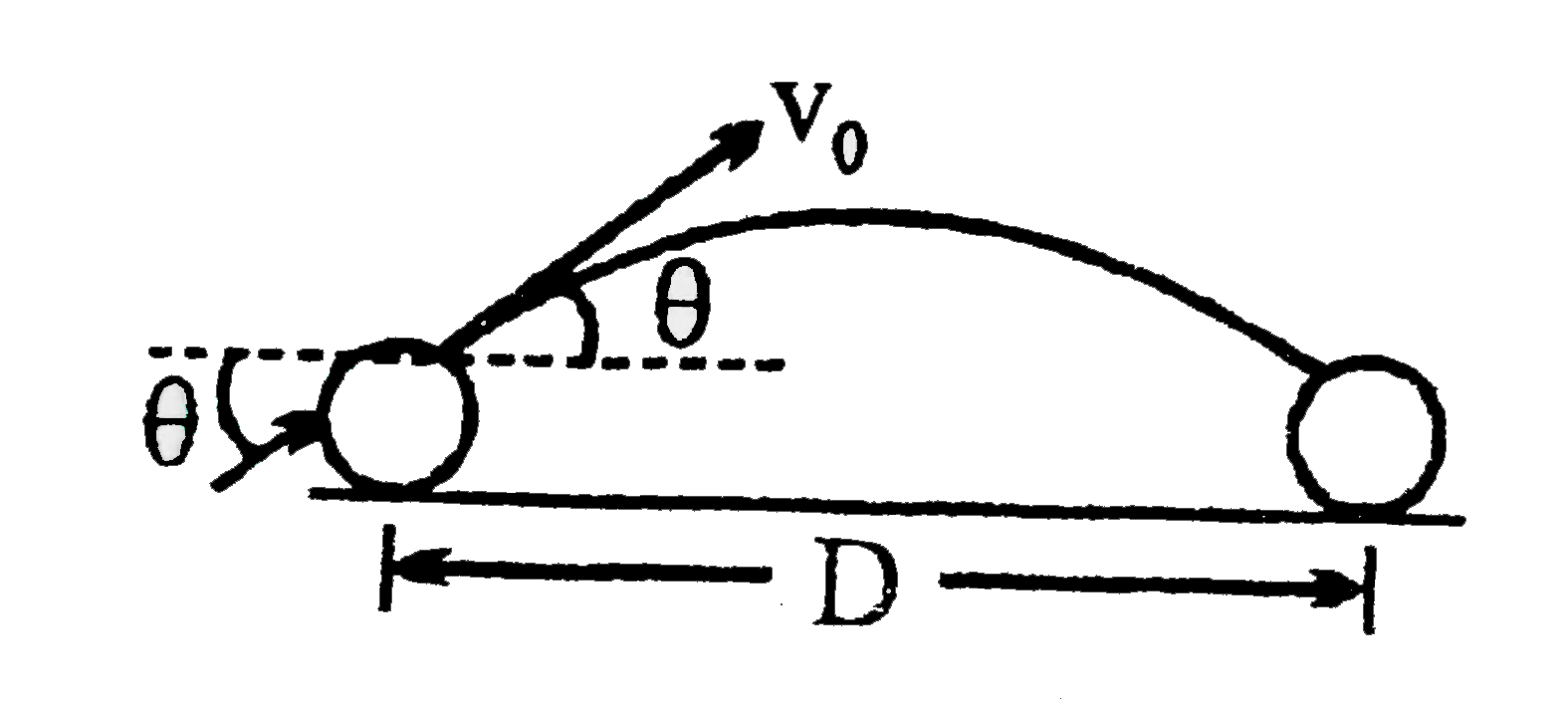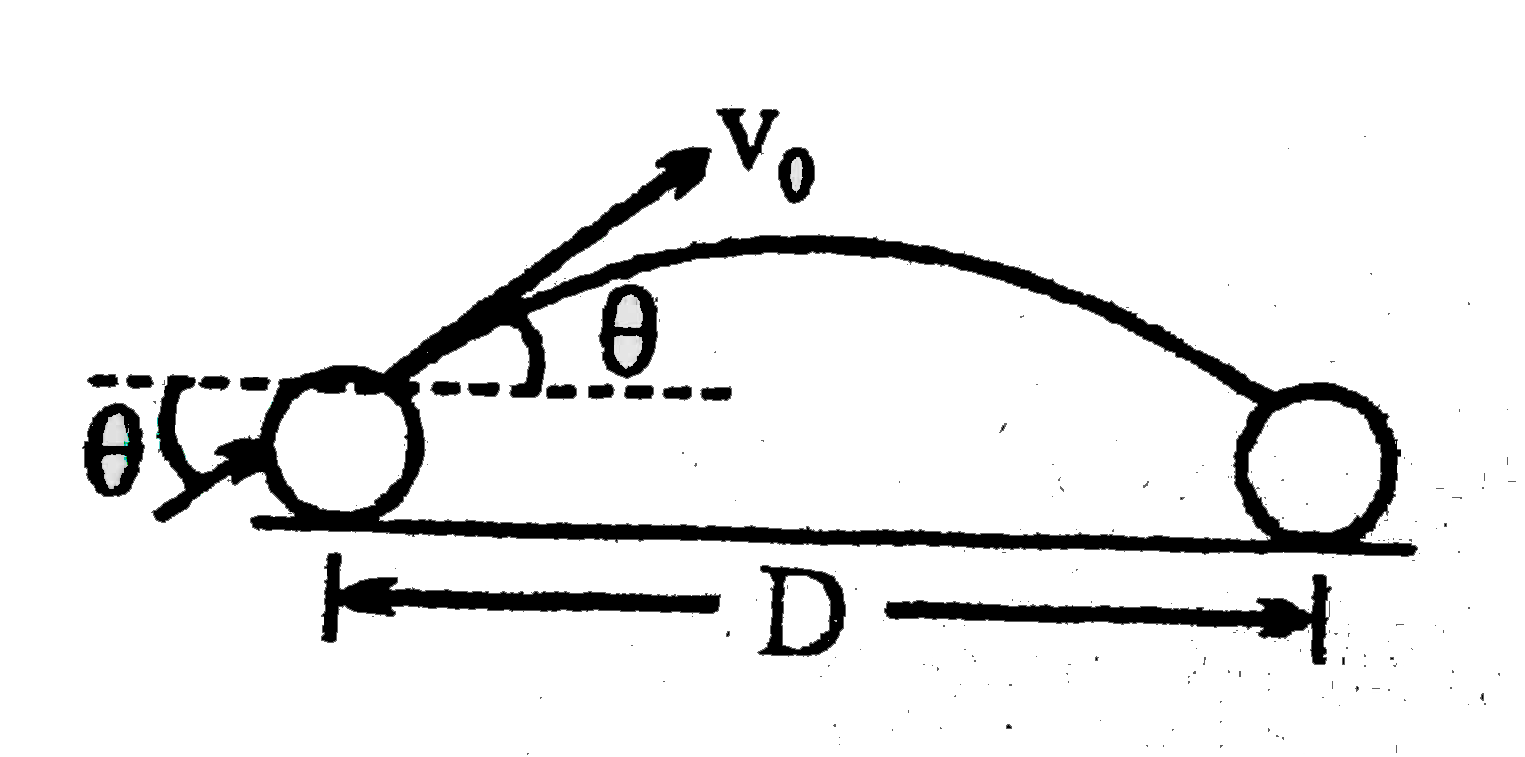When a golf ball is hit by a club there are four phases to its motion : the impact, the flight, the bouncing and the rolling. Note that the parts of this quistion are indepents if you cannot answer something, try the next part. Throughout this problem ignore air resistance and any effects due to the ball's spinning. The impacts is one dimensional at an angle θ, so ball flies in the air at angle θ and lands at a distance D. the collision with ground has coefficient of restituion e. the friction between ground and ball during collision can be ignored. after numerous collision, the ball is seen to have zero vertical and horizontal velocity v1. as it moves on the ground, due to friction rolling bagins after some times, take ball to be a solid sphere

What is the total horizontal distance covered till all collisions are over ?
D1−e
D1−e2
eD1−e
e2D1−e2
The correct Answer is:A
D'=2V20sinθcosθg
D1=e×2V20sinθcosθg
DT=D(1+e+e2+......)
Topper's Solved these Questions
- TEST PAPERSBOOK - BANSALCHAPTER - TEST PAPERSEXERCISE - PHYSICS PART (A)
32 Videos
- TEST PAPERSBOOK - BANSALCHAPTER - TEST PAPERSEXERCISE - PHYSICS PART (B)
3 Videos
- TEST PAPERSBOOK - BANSALCHAPTER - TEST PAPERSEXERCISE - PHYSICS PART- C
4 Videos
- SEMICONDUCTORSBOOK - BANSALCHAPTER - SEMICONDUCTORSEXERCISE - CBSE Question
32 Videos
Similar Questions
A ball is allowed to fall from rest on a horizontal floor from a height of 10m. If there is 20% loss of energy due to impact, then after one impact ball will go upto
View SolutionA ball collides directly with another ball at rest and is brought to rest by the impact. If half of the initial kinetic energy is lost in the impact, then the coefficient of restitution is
View Solution
Knowledge Check
When a golf ball is hit by a club there are four phases to its motion : the impact, the flight, the bouncing and the rolling. Note that the parts of this quistion are indepents if you cannot answer something, try the next part. Throughout this problem ignore air resistance and any effects due to the ball's spinning. The impacts is one dimensional at an angle θ, so ball flies in the air at angle θ and lands at a distance D. the collision with ground has coefficient of restituion e. the friction between ground and ball during collision can be ignored. after numerous collision, the ball is seen to have zero vertical and horizontal velocity v1. as it moves on the ground, due to friction rolling bagins after some times, take ball to be a solid sphere

What is angular velocity of the ball when it rolls purely ?A5v0cosθRBv0cosθ3RC2(1+e)v0cosθ5RD2(1+e)v0cosθ5eRWhen a golf ball is hit by a club there are four phases to its motion : the impact, the flight, the bouncing and the rolling. Note that the parts of this quistion are indepents if you cannot answer something, try the next part. Throughout this problem ignore air resistance and any effects due to the ball's spinning. The impacts is one dimensional at an angle θ, so ball flies in the air at angle θ and lands at a distance D. the collision with ground has coefficient of restituion e. the friction between ground and ball during collision can be ignored. after numerous collision, the ball is seen to have zero vertical and horizontal velocity v1. as it moves on the ground, due to friction rolling bagins after some times, take ball to be a solid sphere

Select the correct statements on the basis of above paragraphADuring collision with the ground neither angular velocity nor horizontal velocity changes.BDuring collision with the ground, anguler velocity changes but horizontal velocity does not change.CDuring collision with the ground, angular velocity does not change but horizontal velocity changesDDuring collision with the ground angular velocity as well as horizontal velocity changes.A ball impinges directly on a similar ball at rest. The first ball is brought to rest by the impact. If half of the kinctic energy is lost by impact, the value of coefficient of restitution is
A12√2B1√3C1√2D√32
A ball of radius r hits a cushion with a pure rolling motion and rebounds, with a pure rolling motion. Find the ratio of the height h of the cushion to the radius r of the ball. Assume that the foce exerted on the ball by the cushion is horizontal during the impact and that the ball hits the cushion normally.
View SolutionA ball collides impinges directly on a similar ball at rest. The first ball is brought to rest after the impact. If half of the kinetic energy is lost by impact, the value of coefficient of restitution (e) is
View SolutionA glass ball is dropped from height 10 m. If there is 15% loss of energy due to impact, then after one impact, the ball will go upto.
View SolutionA ball collides impinges directly on a similar ball at rest. The first ball is brought to rest after the impact. If half of the kinetic energy is lost by impact, the value of coefficient of restitution (e) is
View SolutionA ball is bouncing down a set of stairs. The coefficient of restitution is e. The height of each step is d and the ball bounces one step at each bounce. After each bounce the ball rebounds to a height h above the next lower step. Neglect width of each step in comparison to h and assume the impacts to be effectively head on. Which of the following relative is correct ?
View Solution
